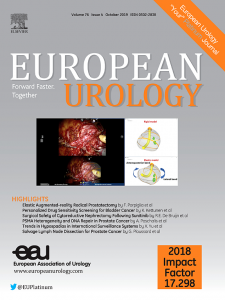A Multicenter Randomized Controlled Trial of Antimicrobial Prophylaxis to Prevent Urinary Tract Infections after Shockwave Lithotripsy for Urolithiasis: The APPEAL Trial
IF 25.2
1区 医学
Q1 UROLOGY & NEPHROLOGY
引用次数: 0
Abstract
Background and objective
Shockwave lithotripsy (SWL) carries a risk of postprocedural infection. Use of antibiotic prophylaxis by clinicians is variable and international guidelines provide conflicting recommendations, reflecting low-certainty evidence. We investigated whether antibiotic prophylaxis reduces bacteriuria and post-SWL urinary tract infections (UTIs).Methods
APPEAL, an international multicenter, blinded trial, randomized adults undergoing SWL for urolithiasis to a single dose of ciprofloxacin or placebo. The primary outcome was the incidence of a composite of bacteriuria or symptomatic UTI after SWL. Other outcomes included the incidence of pyelonephritis or urosepsis.Key findings and limitations
Of the 1722 randomized patients, 28 underwent postrandomization exclusions (mainly nonvisualizable stones). Among the analysis population (n = 1694; median age 50 yr; 30% female), 74% had kidney stones and 26% had ureteral stones. Bacteriuria (without symptoms) or symptomatic UTI occurred in 20 patients (2.7%) in the ciprofloxacin arm and 30 (3.9%) in the placebo arm (risk ratio [RR] 0.68, 95% confidence interval [CI] 0.41–1.15). Symptomatic UTI occurred in ten patients (1.3%) in the ciprofloxacin arm and 21 (2.7%) in the placebo arm (RR 0.49, 95% CI 0.19–1.23). No patients in the ciprofloxacin arm and nine (1.2%) in the placebo arm developed pyelonephritis (RR 0.05, 95% CI 0.003–0.93). No patients developed urosepsis and no serious adverse events occurred.Conclusions and clinical implications
A single dose of ciprofloxacin reduced the risk of post-SWL pyelonephritis, with a modest absolute benefit. The patient importance of this reduction depends on individual preferences in weighing a small absolute reduction in risk against the potential harms and resistance-related implications of antibiotic use. Results from the APPEAL trial will inform global practice and support evidence-based decision-making for patients undergoing SWL.一项多中心随机对照试验:预防冲击波碎石术后尿路感染的抗菌素预防:APPEAL试验
背景与目的冲击波碎石术(SWL)存在术后感染风险。临床医生使用抗生素预防是可变的,国际指南提供了相互矛盾的建议,反映了低确定性的证据。我们研究了抗生素预防是否能减少细菌尿和swl后尿路感染(uti)。方法appeal是一项国际多中心盲法试验,随机选择接受SWL治疗尿石症的成年人,给予单剂量环丙沙星或安慰剂。主要结果是SWL后细菌尿或症状性尿路感染的复合发生率。其他结果包括肾盂肾炎或尿脓毒症的发生率。在1722例随机患者中,28例进行了随机排除(主要是看不到的结石)。在分析人群中(n = 1694,中位年龄50岁,30%为女性),74%患有肾结石,26%患有输尿管结石。环丙沙星组20例(2.7%)患者出现菌尿(无症状)或症状性尿路感染,安慰剂组30例(3.9%)患者出现菌尿(风险比[RR] 0.68, 95%可信区间[CI] 0.41-1.15)。环丙沙星组有10例(1.3%)患者出现症状性尿路感染,安慰剂组有21例(2.7%)患者出现症状性尿路感染(RR 0.49, 95% CI 0.19-1.23)。环丙沙星组没有患者发生肾盂肾炎,安慰剂组有9例(1.2%)患者发生肾盂肾炎(RR 0.05, 95% CI 0.003-0.93)。无患者发生尿脓毒症,无严重不良事件发生。结论和临床意义单剂量环丙沙星可降低swl后肾盂肾炎的风险,并有一定的绝对获益。这种减少对患者的重要性取决于个人在权衡风险的绝对减少与抗生素使用的潜在危害和耐药性相关影响时的偏好。APPEAL试验的结果将为全球实践提供信息,并支持SWL患者的循证决策。
本文章由计算机程序翻译,如有差异,请以英文原文为准。
求助全文
约1分钟内获得全文
求助全文
来源期刊

European urology
医学-泌尿学与肾脏学
CiteScore
43.00
自引率
2.60%
发文量
1753
审稿时长
23 days
期刊介绍:
European Urology is a peer-reviewed journal that publishes original articles and reviews on a broad spectrum of urological issues. Covering topics such as oncology, impotence, infertility, pediatrics, lithiasis and endourology, the journal also highlights recent advances in techniques, instrumentation, surgery, and pediatric urology. This comprehensive approach provides readers with an in-depth guide to international developments in urology.
 求助内容:
求助内容: 应助结果提醒方式:
应助结果提醒方式:


